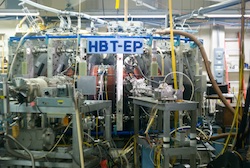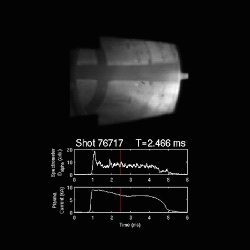To-Ka-Mak
to(roidal'naya) kam(era s) ak(sial'nym magnitnym polem ) ‘toroidal chamber with axial magnetic field.’

HBT-EP was designed to demonstrate the feasibility of a high-beta tokamak stabilized by a combination of a close-fitting conducting wall, plasma rotation, and active feedback. The specific approach taken by HBT-EP was to investigate the combined use of a close-fitting conducting wall and modular saddle coils for the purpose of significantly extending the tokamak beta limit.
HBT-EP is a unique experiment for the investigation of wall-stabilization being the only tokamak device built with adjustable walls and having a vacuum chamber made with several quartz cylindrical breaks. These breaks allow fast penetration of externally-applied magnetic perturbations. HBT-EP has accelerated magnetic islands of nearly sonic speed and the device has been used to access the Troyon normalized beta limit with ohmic heating alone.

HBT-EP has ohmic parameters in the range given by:
D. Gates' thesis provides a brief but comprehensive primer on most of the diagnostics and equipment composing the HBT-EP experiment. Though some aspects are out of date, it can and should be used as a first point of reference to understand how the various pieces of the machine function together.
Portortornec condimenterdum eget consectetuer condis consequam pretium pellus sed mauris enim. Puruselit mauris nulla hendimentesque elit semper nam a sapien urna sempus.
| Magnetic | Optical | Feedback | Other |
|---|---|---|---|
| Ferritic Wall | Soft X-Ray | Data Acquisition | Hall Probe |
| Poloidal Sensors | Thomson Scattering | Power Amplifiers | Bias Probe |
| Toroidal Sensors | Fast Camera | CPCI | Mach/Float Probe |
| Rogowski Coils | D-Alpha | Signal Amps | Rotation |
Copyright © 2015 - All Rights Reserved - apam.columbia.edu
Template by OS Templates